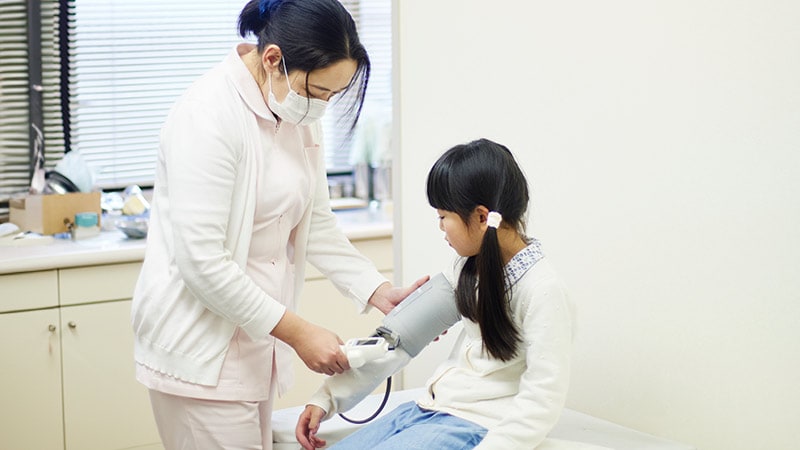Pediatric blood pressure (BP) screening and the prevalence of hypertension (HTN) increased significantly in Canada after the publication of the 2016 Hypertension Canada and 2017 American Academy of Pediatrics guidelines for pediatric HTN, according to a new study.
But BP screening and follow-up by primary care physicians remain suboptimal, according to senior author Rahul Chanchlani, MD, associate professor of pediatric nephrology at McMaster University in Hamilton, Ontario, Canada, and colleagues.
The findings show “there are still some gaps in clinical care,” Chanchlani told Medscape Medical News, adding that the guidelines “need to be better implemented and disseminated among primary care providers.”
The study was published on February 8 in JAMA Network Open.
Screening, Follow-Up Increased
The retrospective, multicenter, population-based cohort study used interrupted time series analysis to examine the association between the introduction of the guidelines and the study outcomes. The researchers defined Era 1, the period before the guidelines, as extending from January 1, 2011, to December 31, 2015. Era 2, the period after the guidelines, extended from January 1, 2018, to December 31, 2019.
The researchers examined data collected from practitioners across seven Canadian provinces using the Canadian Primary Care Sentinel Surveillance Network Electronic Medical Record database. They included children and adolescents aged 3-17 years in their analysis. The primary outcomes were documentation of annual BP screening, documentation of follow-up for high BP at 6 months and 1 year, HTN prevalence, laboratory testing, and medication prescription rates.
The study included 343,191 patients (50.5% female) whose mean age at first encounter was 6.7 years and whose mean age at first BP measurement was 11.6 years.
Overall, BP documentation increased each year. The proportion of patients whose BP was documented at least once annually increased from 13.3% in 2011 to 20.2% in 2019 (P
Follow-up of a high BP measurement also improved slightly. Among patients with an initial high BP measurement, a follow-up measurement within 6 months occurred in 18.1% of patients in Era 1, compared with 18.5% in Era 2. A follow-up measurement within 1 year occurred in 22.3% and 26.1% of patients, respectively. “In other words, if a primary care provider detects high BP, they are not following up on that BP in a timely manner,” said Chanchlani.
The authors suggested that “lower follow-up of high BP may be due to lack of clinician awareness regarding the timing of follow-up due to differences in training or perhaps difficulty in accessing BP percentiles.” They added that children with high initial BP readings were likely followed by pediatric subspecialists, in addition to their primary care clinicians, which would decrease the primary care follow-up measurements.
The proportion of participants with HTN increased from 1.6% in 2011 to 8.2% in 2019 (P
Before the guidelines were published, follow-up laboratory testing and prescribing after a high BP measurement increased. After the guidelines were published, laboratory testing leveled off, and prescribing decreased.
Causality Uncertain
Commenting on the findings for Medscape Medical News, Alexander J. Kula, MD, assistant professor of pediatric nephrology at Northwestern University Feinberg School of Medicine and attending physician at Ann & Robert H. Lurie Children’s Hospital of Chicago, Chicago, Illinois, said that the study “will help inform the direction of follow-up studies to better understand the screening and management of pediatric HTN.” Kula was not involved in the research.
“The authors’ findings demonstrate some effect of HTN guidelines on clinical practice. The strongest evidence for this effect includes the increased rate of screening and reduction in laboratory testing,” he said. “However, if the guidelines were the primary force driving these changes, we would expect other guideline-recommended practices, such as repeat BP monitoring, to increase as well. One possibility is that the publication of guidelines (and surrounding publicity) reminded providers of the general importance of BP monitoring. Beyond the headline, it could be that the specifics of the guidelines were not as easily communicated or remembered.”
Kula stressed that the most important question, which remains unanswered, relates to the role of pediatric subspecialists such as nephrologists and cardiologists in HTN management. “This piece of information would greatly assist with the interpretation of the current manuscript,” he said. “Understanding how well we are appropriately diagnosing and managing pediatric HTN requires a combined assessment of patterns across primary care and subspecialty pediatric fields. The availability of these subspecialists likely influences local treatment patterns. Where subspecialists are heavily involved, general pediatricians may have a much lower threshold for referral (ie, referral before a formal HTN diagnosis, less laboratory testing, less medication prescribing).”
Kula also cautioned that “causality can be challenging to infer from an interrupted time series. We can’t yet say this question of the guidelines is fully answered until we find direct evidence that primary care providers are aware of and influenced by the guidelines. We also need to understand how subspecialists play into all of this.”
McMaster University’s Department of Pediatrics and Department of Medicine supported the study. Chanchlani and Kula reported no relevant financial conflicts of interest.
Kate Johnson is a Montreal-based freelance medical journalist who has been writing for more than 30 years about all areas of medicine.
Source link : https://www.medscape.com/viewarticle/does-canadian-pediatric-hypertension-care-follow-guidelines-2024a10003bi?src=rss
Author :
Publish date : 2024-02-19 03:54:16
Copyright for syndicated content belongs to the linked Source.
